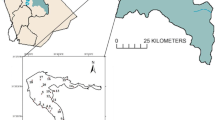Abstract
Al-Wehda dam is an impoundment on the Yarmouk River basin north of Jordan, which came recently into operation. The reservoir is designated to provide water for agricultural, domestic, and industrial uses. Evaluation of seasonal trends in water quality of Al-Wehda dam over the year 2010 showed strong influences by weathering and leaching of geologic units along with discharge of effluents from the adjacent agricultural lands. Seasonal trends in TDS level showed slight variations, though its concentrations have been affected by events of rainfall and evaporation. The presence of total nitrogen (TN) and total phosphorus (TP) promoted the development of photosynthetic algae. Temporal fluctuations in TN, TP, chlorophyll a, COD, and BOD have been observed with peaks occurred in spring season. TN to TP ratios varied seasonally with a minimum ratio observed in spring concurrent with algal bloom. Eutrophication tends to occur throughout the year, though its intensity increased in springtime. A variety of water quality parameters has been used to evaluate water for irrigation use during summer time when the water demand for irrigation increased. Of all parameters evaluated, Na% and TH indicated that the reservoir water is not suitable for irrigation purposes.














Similar content being viewed by others
References
Ayers RS, Westcot DW (1985) Water Quality for Agriculture, FAO Irrigation and Drainage Paper 29(I): 8–96
Basnyat P, Teeter L, Lockaby BG, Flynn KM (2000) Land use characteristics and water quality: a methodology for valuing of forested buffers. Environ Manage 26:153–161
Carlson RE (1977) A trophic state index for lakes. Limnol Oceanogr 22(2):361–369
Cheng XY, Li SJ (2006) An analysis of the evolvement processes of lake eutrophication and their characteristics of the typical lakes in the middle and lower reaches of Yangtze River. Chin Sci Bull 51(13):1603–1613
Chilton J (2006) Assessment of Aquifer pollution vulnerability and susceptibility to the impacts of abstraction. Protecting groundwater for health: managing the quality of drinking-water sources. In: Schmoll et al (eds) WHO drinking-water quality series. IWA, London, pp 199–239
Cloot A, Ros JC (1996) Modelling a relationship between phosphorus, pH, calcium and chlorophyll a concentration. Water SA 22(1):49–55
Ferrier RC, Edwards AC, Hirst D, Littlewood IG, Watts CD, Morris R (2001) Water quality of Scottish rivers: spatial and temporal trends. Sci Total Environ 265:327–342
Forsgerg C, Ryding SO (1980) Eutrophication parameters and trophic state indices in 30 Swedish waste-receiving lakes. Arch Hydrobiol 89:189–207
Ghosh AB, Bajaj JC, Hasan R, Singh D (1983) Soil and Water Testing Methods, A Laboratory Manual, Division of Soil Science and Agricultural Chemistry. IARI, New Delhi 110012. pp. 36–45
Jordan Institution for Standards and Metrology (JS 893/2002) Reclaimed domestic wastewater. Jordan, Amman
Makhlouf I, Abu-Azzam H, Al-Hiayri A (1996) Surface and subsurface lithostratigraphic relationships of the Cretaceous Ajlun Group in Jordan. Natural Resources Authority, Subsurface Geology Division, Bulletin 8
Margane A, Al Zuhdy Z (1996) Groundwater Resources of Northern Jordan, Vol. 1, Part 2: Spring Discharge in Northern Jordan. Technical Cooperation Project “Advisory Services to the Water Authority of Jordan”, BGR & WAJ, BGR archive no. 112708:2 and 3, 12 p., 5 app., 3 maps; Amman
Moh’d B (2000) The geology of Irbid and Ash Shuna Ash Shamaliyya (Waqqas). Map Sheet No. 3154-II and 3154-III. Natural Resources Authority, Geological Mapping Division, Bulletin 46
Nortcliff A, Carr G, Potter RB, Darmame K (2008) Jordan’s Water Resources: Challenges for the Future. Geographical Paper No. 185, The University of Reading
Raghunath HM (1987) Ground water, 2nd edn. Wiley Eastern Limited, New Delhi
Richardson CJ, King RS, Qian SS, Vaithiyanathan P, Qualls RG, Stow CA (2007) Estimating ecological thresholds for phosphorus in the Everglades. Environ Sci Technol 41(23):8084–8091
Sawyer CN, McCarty PL (1967) Chemistry for sanitary engineers, 2nd edn. McGraw Hill, New York
Schramm W (1999) Factors influencing seaweed responses to eutrophication: some results from EU-project EUMAC. J Appl Phycol 11(1):69–78
Todd DK (1980) Groundwater Hydrology, 2nd edn. John Wiley and Sons. Inc. New York 10016. pp. 267–315
Webb BW, Foster IDL, Gurnell AM (1995) Hydrology, water quality and sediment behaviour. In: Webb BW, Foster IDL, Gurnell AM (eds) Sediment and water quality in river catchments. Wiley, UK, pp 2–15
Wilcox LV (1948) The quality of water for irrigation use. U.S. Department of Agriculture, Technical Bulletin 962. U.S. Department of Agriculture, Washington, DC, p 40
Wilcox LV (1955) Classification and use of irrigation waters. U.S. Department of Agriculture Circular 969. U.S. Department of Agriculture, Washington, DC, p 19
Yang X, Wu X, Hao H, He Z (2008) Mechanisms and assessment of water eutrophication. Journal of Zhejiang University of Science 9(3):197–209
Acknowledgment
The author would like to thank Tariq Alkhamaiseh for his assistance in water sampling, Dept. of Earth and Environmental Sciences at Yarmouk University and the Laboratory of Water, Environment and Arid Regions Research Center at Al-albayt University for providing all necessary facilities for analyzing water samples. The author appreciates Dr. Rafie Shinaq, Dr. Sameh Gharaibeh, and the anonymous reviewers for the time and contribution in reviewing and providing comments on this study.
Author information
Authors and Affiliations
Corresponding author
Rights and permissions
About this article
Cite this article
Al-Taani, A.A. Seasonal variations in water quality of Al-Wehda Dam north of Jordan and water suitability for irrigation in summer. Arab J Geosci 6, 1131–1140 (2013). https://doi.org/10.1007/s12517-011-0428-y
Received:
Accepted:
Published:
Issue Date:
DOI: https://doi.org/10.1007/s12517-011-0428-y




